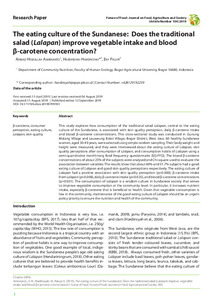Aufsatz

The eating culture of the Sundanese: Does the traditional salad (Lalapan) improve vegetable intake and blood β-carotene concentration?
Zusammenfassung
This study explores how consumption of the traditional salad Lalapan, central to the eating culture of the Sundanese, is associated with skin quality perception, daily β-carotene intake and blood β-carotene concentrations. This cross-sectional study was conducted in Gunung Malang Village and Leuweung Kolot Village, Bogor District, West Java. 60 healthy Sundanese women, aged 30-49 years, were selected using simple random sampling. Their body weight and height were measured, and they were interviewed about the eating culture of Lalapan, skin quality perceptions after consumption of Lalapan, and consumption habits of Lalapan using a semi-quantitative month-long food frequency questionnaire (SQ-FFQ). The blood β-carotene concentrations of about 25% of the subjects were analysed and Chi-square used to evaluate the association between variables. The results show that about 60% and 51.7% subjects had a good eating culture of Lalapan and good skin quality perceptions respectively. The eating culture of Lalapan had a positive association with skin quality perception (p=0.000), β-carotene intake from Lalapan (p=0.008), daily β-carotene intake (p=0.035), and blood β-carotene concentrations (p=0.031). The consumption of Lalapan is a wisdom culture in Sundanese society that serves to improve vegetable consumption at the community level. In particular, it increases nutrient intake, especially β-carotene that is beneficial to health. Given that vegetable consumption is low in the community, maintenance of the good eating culture of Lalapan should be an urgent policy priority to ensure the nutrition and health of the community.
Zitierform
In: Future of Food: Journal on Food, Agriculture & Society Volume 7 / No 2 (2019-09-12) , S. Article Number 104 ; ISSN 2197-411XSammlung(en)
Vol 07, No 2 (2019) (Future of Food: Journal on Food, Agriculture & Society // The Future of Food Journal: Journal on Food, Agriculture & Society)Zitieren
@article{doi:10.17170/kobra-20190709593,
author={Amrinanto, Ahmad Hisbullah and Hardinsyah, Hardinsyah and Palupi, Eny},
title={The eating culture of the Sundanese: Does the traditional salad (Lalapan) improve vegetable intake and blood β-carotene concentration?},
journal={Future of Food: Journal on Food, Agriculture & Society},
year={2019}
}
0500 Oax 0501 Text $btxt$2rdacontent 0502 Computermedien $bc$2rdacarrier 1100 2019$n2019 1500 1/eng 2050 ##0##http://hdl.handle.net/123456789/11419 3000 Amrinanto, Ahmad Hisbullah 3010 Hardinsyah, Hardinsyah 3010 Palupi, Eny 4000 The eating culture of the Sundanese: Does the traditional salad (Lalapan) improve vegetable intake and blood β-carotene concentration? / Amrinanto, Ahmad Hisbullah 4030 4060 Online-Ressource 4085 ##0##=u http://nbn-resolving.de/http://hdl.handle.net/123456789/11419=x R 4204 \$dAufsatz 4170 7136 ##0##http://hdl.handle.net/123456789/11419
<resource xsi:schemaLocation="http://datacite.org/schema/kernel-2.2 http://schema.datacite.org/meta/kernel-2.2/metadata.xsd"> 2020-01-14T12:30:45Z 2020-01-14T12:30:45Z 2019-09-12 doi:10.17170/kobra-20190709593 http://hdl.handle.net/123456789/11419 eng Section Specialized Partnerships in Sustainable Food Systems and Food Sovereignty at the University of Kassel, Germany and Federation of German Scientists (VDW) Urheberrechtlich geschützt https://rightsstatements.org/page/InC/1.0/ β-carotene consumer perception eating culture Lalapan skin quality 630 The eating culture of the Sundanese: Does the traditional salad (Lalapan) improve vegetable intake and blood β-carotene concentration? Aufsatz This study explores how consumption of the traditional salad Lalapan, central to the eating culture of the Sundanese, is associated with skin quality perception, daily β-carotene intake and blood β-carotene concentrations. This cross-sectional study was conducted in Gunung Malang Village and Leuweung Kolot Village, Bogor District, West Java. 60 healthy Sundanese women, aged 30-49 years, were selected using simple random sampling. Their body weight and height were measured, and they were interviewed about the eating culture of Lalapan, skin quality perceptions after consumption of Lalapan, and consumption habits of Lalapan using a semi-quantitative month-long food frequency questionnaire (SQ-FFQ). The blood β-carotene concentrations of about 25% of the subjects were analysed and Chi-square used to evaluate the association between variables. The results show that about 60% and 51.7% subjects had a good eating culture of Lalapan and good skin quality perceptions respectively. The eating culture of Lalapan had a positive association with skin quality perception (p=0.000), β-carotene intake from Lalapan (p=0.008), daily β-carotene intake (p=0.035), and blood β-carotene concentrations (p=0.031). The consumption of Lalapan is a wisdom culture in Sundanese society that serves to improve vegetable consumption at the community level. In particular, it increases nutrient intake, especially β-carotene that is beneficial to health. Given that vegetable consumption is low in the community, maintenance of the good eating culture of Lalapan should be an urgent policy priority to ensure the nutrition and health of the community. open access Amrinanto, Ahmad Hisbullah Hardinsyah, Hardinsyah Palupi, Eny publishedVersion ISSN 2197-411X No 2 Future of Food: Journal on Food, Agriculture & Society Article Number 104 Volume 7 </resource>
Die folgenden Lizenzbestimmungen sind mit dieser Ressource verbunden:
Urheberrechtlich geschützt

